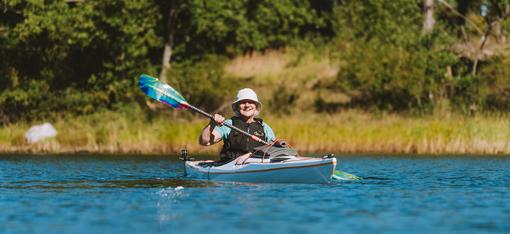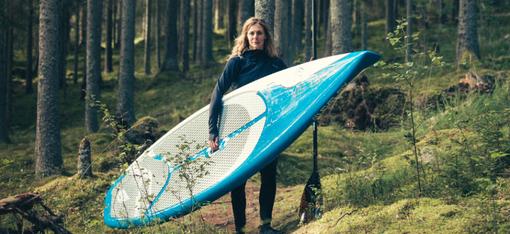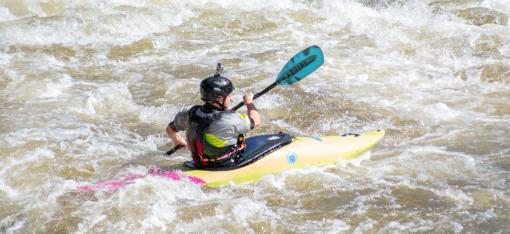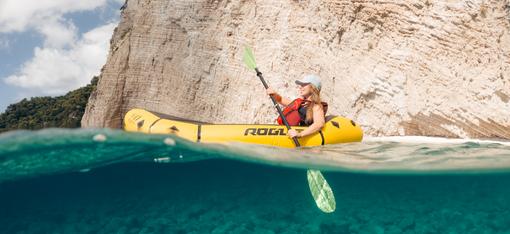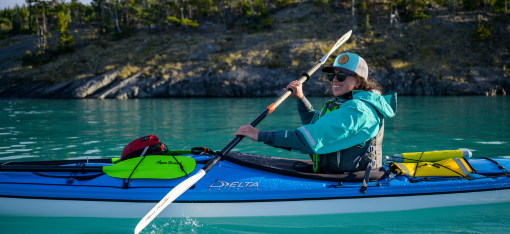The Wonderful World of Sea Kayaking in Vancouver Island
13-minute read
Aqua Bound Ambassador Bree Roberts has guided sea kayak tours in the territories of the Kwakwaka'wakw peoples on Vancouver Island since 2012. She has a lot to share about this area that has become her favorite in the world.

Bree is a Sea Kayak Guides Alliance of British Columbia Level 3 guide with North Island Kayak, based in the community of Telegraph Cove on the northeastern side of the island. We sat down with her recently to hear her story and learn why she loves sea kayaking life there so much.
Here’s our conversation with Bree:
AQUA BOUND: Why is sea kayaking in Vancouver Island so special?
BREE: Vancouver Island is one of those places that you could explore endlessly. It’s very lively with a lot of diversity, meaning the waters and ecosystems are quite dynamic. You can have easy kayaking with very small tides and a little current to very big water, large ocean swell and large tidal exchanges that create a bunch of current. It can get pretty wild if you get caught in the wrong place at the wrong time.
There are a lot of mountains in the northern half of the island, and then the further south you go, they turn into hills. And there’s a relatively small population of people, so there are lots of remote areas. The remoteness is something to be considered when planning longer kayak trips.
It’s really, really beautiful and there’s always something to learn. If you have a curious mind, you could be learning forever there.

AB: What kind of wildlife is common in Vancouver Island?
BREE: It’s amazing! I think it’s one of the things everybody falls in love with. There’s so much biodiversity, and that’s a big part of the touring I do.
From the tops of the trees down to the bottom of the ocean, every single layer has different animals living in it. You’ll see bald eagles, great blue herons, lots of diving birds, migratory birds—even birds that shouldn’t be there but find it and stick around for a while.
In the ocean, we have three different populations of killer whales around Vancouver Island: the northern residents, the southern residents and the offshore whales. We also have humpback whales all over the Island. Gray whales tend to migrate on the west coast. Pacific white-sided dolphins and different species of porpoise are here, too.
Every few years, I’ll see an elephant seal. And we have lots of stellar sea lions that are huge and noisy, harbor seals, salmon and herring. We have intertidal life that’s so beautiful, with so many animals and so many colors. It’s like looking in a museum, paddling through the intertidal zone.
AB: What is most of the coastline like?
BREE: It’s pretty rugged with not much sand. Once you get towards the north coast of Vancouver Island and start to crest around to the west side, you’ll find sandy beaches. However you will also find these to be some of the most remote places on the island.
Where I am is a lot of coastal gravel. Some of the rocks are nice and smooth, but there are some big rocks you’re having to move safely through when launching or landing your kayaks in lower tides.

AB: What else makes Vancouver Island a unique sea kayaking environment?
BREE: The dynamics of the water is really interesting. Where I guide are lots of currents and big tides. Something you think you know what to expect when you go around the corner, but maybe the wind is doing something different or the current is a little stronger than you expected. It keeps you on your toes!
And then there’s the tourism community. There are a lot of different types of guiding out here. There are a few sea kayak companies and we’re all generous with each other, especially among the guides.
We’re not competing in the sense that we need to keep secrets, as we all share the goal of keeping people safe and educated. We’ve got companies that focus on grizzly bear tours, whale watching tours, and then a lot of kayak guides doing multi-day trips.
The weather can be hit-and-miss. Some summers are beautiful with enough rain to keep everything safe and healthy but not a lot of wind. That’s what last year was like—it was wonderful! The year before, we had crazy wind that influenced a lot of our summer. There can be a lot of fog, so we need to be savvy with navigation.
We also have to be savvy with navigation around other vessels. The commercial vessels may be expecting us, and we can communicate with them because we’re on marine VHF radios. But it’s the private vessels that can be a bigger variable depending on who’s behind the wheel and what motivations they have.
Vancouver Island is one of those places where it’s almost like you meet the love of your life. Once you start working on the water there, nothing can replace it.

AB: Can beginning sea kayakers paddle there?
BREE: With a guide, absolutely. For most of Vancouver Island, people should consider hiring a guide because there’s so much to consider when you’re out there. Something that might look like the closest route may actually be the most dangerous. But I’ve guided people from four years old to their early 80s with various skill levels.
The only limitation I’ve noticed will be a person’s size because sea kayaks are so specifically proportioned. You have bulkheads, and each boat is only so wide. So people who are very tall or wide could have a problem fitting comfortably.
However, we do have a fleet of kayaks that are extra wide with extra legroom in the back cockpit. I love to be able to accommodate people that way.
Part of guiding is anticipating what people will need and making adjustments for peoples’ size without highlighting it. I don’t want people to feel like they can’t do this because of their size. But it’s important that there’s a realistic understanding regarding the size limitations in sea kayak touring.

AB: When is your sea kayak season?
BREE: Our overnight tours start around June 1st and finish around September 20th. I feel like all the guides—and a lot of tourists on the water—always wait for September because it’s so beautiful and there are so many animals. The animals are in a feeding frenzy, getting ready for their migrations.
It’s close to the end of the salmon run, so the killer whales are getting as much salmon as they can. The humpbacks are amazing. There’s one body of water called Blackfish Sound that we like to call “whale soup” or “whale city.” Sometimes we’re trying to cross, and a half dozen humpbacks are swimming around in this two-mile crossing!
September at nighttime is just magical. You’re in camp and can hear the sea lions roaring. A pack of wolves moved in last year and we could hear them howling. Then one humpback in particular does a lot of singing at the surface. We hear a lot of strange noises from this whale—one of the sounds is like a bellowing dinosaur! It’s amazing. It just resonates through the whole sound. And the killer whales talk to each other sometimes, which we might hear from the shoreline when they come up.
So I think we guides love September because it’s so magical. When the weather cooperates, it is beautiful. But there’s this huge variable of wind and rain. We can have a really wet and windy September where a lot of tours get modified. Sometimes the safest solution is to take water taxis to more sheltered places. I think the word taxi implies a level of convenience, but it takes many hands and moving parts to facilitate.
As far as guests, I think probably the end of July into early September would be their highest chance of getting that full experience with lots of different animals and hopefully more stable weather.

AB: What’s your personal favorite sea kayaking spot on Vancouver Island?
BREE: Where I guide, for sure. It’s always nice to get across Johnstone Strait because it’s a long stretch of water that can get windy. Once you’re on the other side of Hanson Island into Blackfish Sound, the currents are more manageable. The Broughton Archipelago, just on the other side of Blackfish Sound, is a series of around 200+ islands that you can tour around.
We have an island called Swanson Island in Blackfish Sound that’s probably one of my favorite places in the world. That’s the spot where you can sit on the shoreline and have humpbacks swim by your feet.
AB: Tell us about the company you guide with, North Island Kayak.
BREE: This will be my 20th year guiding [2025]. When I applied there in 2012, I wanted to be a sea kayak guide, but had no idea it was the place to see whales. I was just happy to be on the water, and it turns out it’s probably one of the best places in the world to have these wildlife experiences.
North Island Kayak has been so supportive. They let the lead guides (especially myself and my colleague who have a lot of experience) have a lot of autonomy to make decisions to run our trips the way we need to.
This is really important because of the weather, currents, people’s abilities, and lots of other variables—it gives us the freedom to adapt and make the right decisions to keep everybody safe while providing the best experience possible.
Also, the owners are very inclusive. We have a lot of diversity on our team. I like how we operate like that so people can come and experience this without any prejudice.

We also have a lot of support, which is huge for me. We were bought by Prince of Whales Whale Watching in 2019 and they started operating in 2020. We have a big team of maintenance people who move kayaks and equipment for me and maintain our six base camps.
That gives me more energy throughout my season and also protects me from doing damage to my body.
There’s a lot of heavy lifting with kayaking and I’m 41 now. I want to be able to keep guiding, and don’t want my body to be the reason I can’t. So having that support team of these big, strong guys to help us is amazing.
We also have a wonderful head chef. We have a very nice variety of food we can serve. It’s not a set menu, as we need to be able to accommodate dietary restrictions and allergies. I plan the menus and the chef team gets me everything I need. Then I can pack it the way I like for preservation and to be strategic with where the food goes in the boats.
I really appreciate and respect the owners. They’ve given back to the community up here in many ways. And I’ve had nothing but support from them.
This year, on New Year’s Eve, there was a big fire in Telegraph Cove. We lost a huge section of the tourist area, including, sadly, the Whale Interpretive Centre. We lost our kayak shop and some of our gear; the grizzly bear tour operation burnt down—it was a big, crazy thing.
There are a lot of variables for this summer, but thankfully, the community plans to be open and we’ll be operating.

AB: What’s your own history getting into sea kayaking?
BREE: I grew up in the prairies of Saskatchewan, then moved to the mountains when I was 18. I wanted to be able to do these activities but didn’t have any skills and couldn’t find people to do it with. Then I started to meet guides and realized there’s this thing people do called guiding.
I was able to get a job in 2005 without any experience because I interview well, am a good decision-maker and am teachable. I completed a 2-year outdoor adventure guiding program and that’s where I started sea kayaking.
We started on rivers to get used to currents and the boats. Then we did a trip in the Great Lakes, Georgian Bay. Those lakes are so big it’s like the ocean with a bit of swell and a lot of island hopping. To graduate, my group’s final project was kayaking the Outer Banks in North Carolina.
After guiding hiking and whitewater canoeing for a few years, I switched to sea kayaking in 2012. Because I had guiding experience, I was able to challenge some of the certification levels and was able to become a lead guide right away. But I was a lead guide on a very short leash.
My fifth season is when I took my last exam to become a Level 3 guide, the highest level of certification for sea kayaking. With a Level 3 certification, one could advance into an instructor/examiner role.
I like to teach my guests paddling skills and why I make the decisions I do when we’re on a tour. I’ve learned that if you can get people doing a good forward stroke, that’s a big part of the group management. You don’t have to be the strongest person to paddle a kayak, but you do need to have good technique.
Last year, I started teaching more of my guests a few moving water maneuvers because the currents can get strong. The waves might not be too big, but there are big eddy lines and a lot of converging waters. So I’ve been teaching them how to turn their boats into and out of eddy lines or how to ferry across the current. And they love it! It’s a lot of fun. The more skills I can impart to a group, the more enjoyable the trip is for them.

Bree kayaking in Vancouver Island waters
AB: What’s your history with Aqua Bound?
BREE: The very first paddle I ever bought myself was an Aqua Bound whitewater canoe paddle, and I was pretty proud of it. But I was young and I lost it somewhere along the way! North Island Kayak’s whole stock of paddles is Aqua Bound.
Having a fiberglass shaft with a plastic blade is really nice for people, especially at an entry level of kayaking. The fiberglass doesn’t get cold and the plastic blades are durable.
I have the Tango Carbon bent shaft, which I love. I can go a little bit faster with it, and I also use it a lot with my guests. I watch people all the time and am always checking in with them. If someone is at risk of an overuse wrist or shoulder injury, I’ll give them my paddle for the trip.
It feels good to be able to provide people with modifications so they can enjoy their tour. Feeling physically uncomfortable is very distracting and I want my guests to be able to focus on the experiences around them.
I really like how Aqua Bound has something for everyone—from people who’ve never paddled to those who do nothing but paddle. It’s wonderful to have that range and make it available for people. In my experience, just having that access to the outdoors is one of the nicest things you can do for yourself.

Bree Roberts, sea kayak guide and Aqua Bound Ambassador
I’m really happy to be part of this Ambassador team and be able to share the product and sport with people.
(All photos courtesy of Bree Roberts)
What paddling questions can our friendly Customer Service team help you with? Contact us at 715-755-3405 or sales@aquabound.com
More for you...

